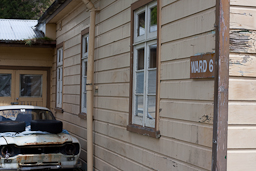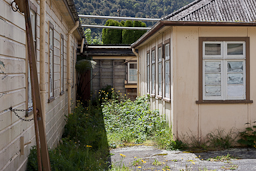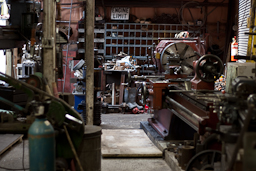


The end of October marked the first time I managed to find both the time and the money required to go to a photography conference. I've been quietly keeping my eye open for sometime to see what was out there and so when I saw that the Photographic Society of New Zealand was holding a regional annual conference it immediately go my interest. Indeed the bookings for it opened early May and I got my entry in about April and spent a large chunk of the year anticipating the conference. The danger of such an advance booking is that you spend a lot of time anticipating and possibly over selling it to yourself.
It was held out at what is now called the Silverstream Retreat but back sixty years was originally built as an Army Hospital during World War II. This was not merely a historical curiousity as I have had the pleasure of an email correspondance with one of the veterans of that war who spent time at this hospital and indeed did chunks of his basic training out here in New Zealand. He had asked what had become of the hospital and I had been planning for a while to make the trip out there with a camera to document the place and show him what it looked like now. It has had a chequered history of mostly varying stages of neglect with it now in the private hands of a group that is renovating the buildings for use as a conference/convention centre.
 At the time of the conference this process was only partly completed
so the site had an interesting mix of fully updated accomodation suites,
partly done ones (which were cheaper and thus where I stayed for the
weekend) and almost completely untouched from WW2 days when they were
built. Checking around the site I found some old graffiti/artwork that I
wouldn't be surprised to find dates from the second world war as the
style that goofy, pluto and mickey were drawn in was reminiscent of the
older Disney drawings. The unrenovated buildings have a degree of
beautiful desolation about them that makes the sense of past history
almost tangible.
At the time of the conference this process was only partly completed
so the site had an interesting mix of fully updated accomodation suites,
partly done ones (which were cheaper and thus where I stayed for the
weekend) and almost completely untouched from WW2 days when they were
built. Checking around the site I found some old graffiti/artwork that I
wouldn't be surprised to find dates from the second world war as the
style that goofy, pluto and mickey were drawn in was reminiscent of the
older Disney drawings. The unrenovated buildings have a degree of
beautiful desolation about them that makes the sense of past history
almost tangible.
In more recent history the conference itself got under way on Friday night with an opening speech from John Doogan. John is an interesting guy, a landscape photographer by trade, he has made the switch from film to digital wholeheartedly. Indeed he is an Adobe spokesman so there was a healthy degree of software promotion as an undercurrent to his talks. (To be fair what can be done with the software is amazing and it wasn't an obnoxious over-sell, more a nice laidback demonstration of what can be done.) His opening speech was a potted summary of his career and just how much the technology has changed. Both in terms of ease and outright capability of what can be done both at the professional and amateur level. It was a fun engaging talk that set the tone for the conference as a whole - fun and engaging.
Saturday morning say the Keynote speech given by Judi Lisantos. A self taught photographer Judi approaches photography from the more subject and emotion driven end. Primarily a wedding photographer she has made a name for herself with her 'trash the dress' wedding shoots where married couples go into unsual (and often water laden) areas to have some fun. The end result are images that are often very spontaneous and unusual. As a result her talk was less technical and more on the end goals of the images you are trying to create and what she has tried to do with her work. An important strand of the talk was showing the documentary images she made of the fairly devestating flooding her home town suffered mid 2009. While Judi is a bit more touchy-feely than I care for her talk did have several key things in it for me. First, you can be self taught and still produce highly professional work. Second that thinking a little outside the box and challenging the normal photographic 'rules' can produce some stunning images. Third that data backup is highly important as she had a few stressful days making sure her digital data was secure during these floods.
I know of quite a few people who invest in services like Amazon's S3 system to ensure there is an offsite backup in case of disaster. Seeing the images of Judi's computer room flooded several feet deep drove home the importance, especially for professionals, of both backing your data up but doing so remotely as well as locally. I still am a little undecided if, for the amature, the cost of Amazon's service is worth it. I suspect I might be being a little parsimonious financially and will have to look into it more in the future. The other big point Judi was stressing that you have to do self-portraiture - just so that you can know what the experience is like of being in front of the camera. After all photographers routinely ask others to do it so her point was that least we should do is understand it so we can make our subjects comfortable. It is a fair point but I can't say I will be following her example with the variety of artistic nudes featured.
A smart part of the conference design was that the day was broken up between presentations and activities like workshops or fieldtrips where you actually got to do something. Saturday had kicked off early with a visit to the Pahatanui Inlet which is a bird reserve. While I had fun I obviously wasn't awake for the trip because I picked a slow glass lens and entirely wrong shooting speeds for what I was trying to capture. Making the trip pretty much a bust, I must go back and do it again properly sometime in the future. This meant by the time of the keynote speech I was happy to settle down, rest my feet and just listen. We then had a workshop session of which five or six were run simultaneously and people picked the ones they were most interested in. I picked John Doogan's 'Digital Darkroom'.
This was fun and interesting. In it he used low light, an LED torch and a camera firmly mounted on a tripod controlled via LiveView to shoot multiple exposure of a still life subject. Each exposure used the LED torch to provide a different source of light with a Key light to provide the primary lighting exposure, fill in lighting on both the backdrop & some pears in the back of the shot and some general ambience lighting. All done with one battery powered LED torch instead of the careful rig of multiple lights that film would have required to acheive the same shot. He heavily used Lightroom to collect the images then throw them over to photoshop for combination to produce the final result. All in all an interesting demonstration of the power that exposure combination in the digital realm can bring. Even neater was seeing it all done in realtime during the workshop so we got to see both the photographic technique and the workflow after the exposures. As with his presentation on the opening night John was a relaxed informal speaker who made the workshop a pleasure to attend as he often ellicited input from the attendees and was happy to explain the hows and whys of what he was doing. The bit that made it a kick for me, and to a certain extent my friend who had attended the conference as well, was that the fire and ice shot I composed a scant couple of weeks before the conference also heavily relied on LED torches to do the lighting. With the advent of easy colour correction the LED torches provide a very consistant chromatic light that makes shooting with them easy. Simply take a 'keying' shoot of some white paper lit by the same torch and then use that as the colour reference to correct all your subsequent shots. So it was doubly a thrill to see a professional using the same techniques I had just worked out shortly before hand. It validated that the direction I was heading in on my own was correct.
 After lunch came the next big fieldtrip event. Some travelled by bus
off to Efil Doog, an unusual garden in the Upper Hutt that has a variety
of plants and structures in the garden that make for good photographic
material, others to Staglands which was more focused on close encounters
with various animals. I opted to stay for the Silverstream Steam Railway
Museum who operate a small fleet of steam powered locomotives, actively
restoring several of the engines and carriages, across a few kilometres
of track. Sadly there had been a communications mix up somewhere which
meant that, after standing around for a little bit while it was sorted
out, the engine simply didn't have time to have a head of steam built
up. So we didn't get to see the train actually running. But a side
benefit was that the lack of trains moving meant we got access into the
workshop area proper where we could see the work being done.
After lunch came the next big fieldtrip event. Some travelled by bus
off to Efil Doog, an unusual garden in the Upper Hutt that has a variety
of plants and structures in the garden that make for good photographic
material, others to Staglands which was more focused on close encounters
with various animals. I opted to stay for the Silverstream Steam Railway
Museum who operate a small fleet of steam powered locomotives, actively
restoring several of the engines and carriages, across a few kilometres
of track. Sadly there had been a communications mix up somewhere which
meant that, after standing around for a little bit while it was sorted
out, the engine simply didn't have time to have a head of steam built
up. So we didn't get to see the train actually running. But a side
benefit was that the lack of trains moving meant we got access into the
workshop area proper where we could see the work being done.
Maybe I am too much of a gearhead but steam trains always interest me. Such a staple of the industrial revolution these machines have now largely disappeared from the world. It fascinates me that it could so heavily dominate the world and yet, in a scant fifty years, largely disappear. It always makes me wonder what next is to be added to the list of technical underpinnings of society that will disappear. So this was a profussion of interesting shapes and elements to look at. Because Judi was continuing her popular 'trash the dress' workshop through the day we had most photographers focused on the models wearing the wedding dresses. Being more interested in the technology I went into areas I don't think anyone else really visited despite having the chance. Possibly having the engine running might have changed this but the practical upshot was that most of time I was left alone to take the shots I wanted.
One of the unintended but nice side effects of going to the Railway, which was right next door to the convention grounds, was that we got back from it in plenty of time to see what I found to be the highlight of the conference. This was the 1929 Studebaker the Mr Bixley and family have renovated and maintain in a showroom state. Again the appeal is in seeing a type of hardware that now is exceedingly rare. Not only is the car itself in pristine condition but the Bixley family go to some trouble to dress in period appropriate clothing to match with the car. This was a real pleasure to photograph with the family all being very approachable and amenable to posing for photographs. The daughter especially seemed to be enjoying herself which is good given that she had a large collection of strangers pointing cameras at her. Mr Bixley himself was a font of interesting information about the car chatting happily about the cost of the wheel rims, which have to be bespoke made now, and his experience in providing the car for use in Peter Jackson's King Kong. (Much to his surprise the car made it into the film for something like ten seconds of time.)
I think he got a kick out of people appreciating the care and effort that he and his wife have put into the car. Certainly I hope he had a pleasant experience with us because it just was an absolute joy to see this car in this condition. My one regret is that the image of the headlamp chrome I got the focus slightly soft on it (hard to see in the small version of it here) and while I did check it on the camera's LCD screen I obviously didn't check carefully enough. Hopefully I get a chance to re-do that shot sometime in the future. One thing that made this a little more special was that the tour buses from Efil Doog and Staglands both ran somewhat late so this became a special little event that those of us who stayed on site got to enjoy.
Saturday concluded with a social evening meal that was themed for the 1940s to go with the ex-army hospital venue. Entertainment during the meal was provided by some theatresports performers who provided a murder mystery and a variety of colourful suspects who mingled during the meal to give us both their backstory and clues. Fun but not quite as organised as they provided some clues that they later re-canted but only told half the room that they had. This made my submission on the murder mystery sopmewhat redundant - which was a shame as the table had fun creating it. Sunday was a half day with one workshop and then the concluding address. That workshop was given by the Enderbys, a married couple who specialise in underwater photography and live right next to a marine reserve up north, which talked about the process of selling your images for use in magazines. This was a great workshop, more an informal lecture really, that talked about the tips and tricks of being published. They ended up being more article writers with photographic illustration and effectively get paid to visit areas to produce tourist information material. They pointed out various pitfalls like the magazines often wanting to grab ownership of the material (something that strongly advocate against as often a good image will be in demand to several magazines) and the occasional issue of rights infringement and inappropriate use of images. Their approach to this was more one of formally protesting but more relying on the fact that they will want images again in the future and penalising financially magazines that do have bad habits of not paying for reproduction rights. As he said the aim is to develop a long term relationship with the editors so being overly punative is counter-productive so a careful balance needs to be struck.
All in all this was a fun conference to attend. It was well organised with only one major slipup that detracted a little and the emphasis was on both learning and doing. While I am aware that another club is going to be organising the next conference I certainly came away from this keen to attend the next one. We shall just have to see if finances and time permit. But for budding photographers who want to both learn and network a little I think something like is well worth the time. If only to get validation that the techniques you have been developing on your own are heading in the right direction. It also is useful to compare your own work against others to see new areas you might want to learn or things you want to improve in your own images. So I think congratulations need to go out to the Upper Hutt Photographic Society who organised a very succesful event.
For those who are interested, the convention website is http://www.get-a-grip.co.nz/. There is a gallery on there where several attendees have contributed their more noteworthy shots from the conference.